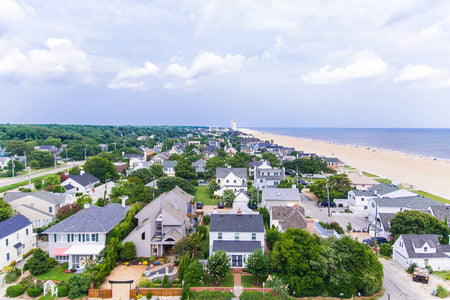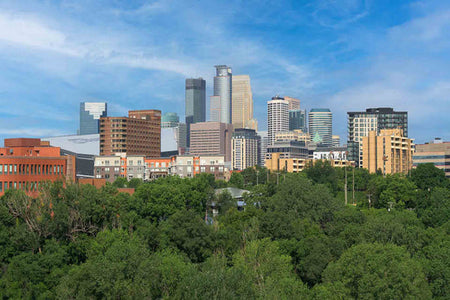- Maryland’s diverse climate leads to distinct allergy seasons — tree pollen peaks in spring, grass pollen in summer, and ragweed in fall.
- Preventive measures, such as taking medications early, monitoring pollen levels, and maintaining clean indoor air, can reduce symptoms.
- Allermi nasal spray provides Maryland residents with a personalized, multi-ingredient option to combat seasonal allergies in Maryland effectively.
Maryland’s mix of coastal plains and mountain areas creates different weather patterns that can affect local allergens. This makes the state a common place for allergy sufferers, as the changing seasons bring a variety of pollen-producing plants.
From tree pollen in the spring to grass and weed pollen in the summer and fall, the air in Maryland can be filled with allergens that can trigger symptoms for many residents.
In this article, we will explore when allergy season starts, peaks, and ends in Maryland, and offer insights on how to prepare for and cope with common allergens.
When is the Pollen Season in Maryland?
Pollen season in Maryland varies slightly depending on the region. It is influenced by local climate and vegetation.
In Western Maryland, tree pollen peaks earlier in the spring, typically starting in March and continuing through April. This is due to the higher elevations which can lead to earlier blooming of trees.
Grass pollen is more noticeable in late spring and can last into early summer, peaking around May to June. The warmer temperatures in late spring trigger grass growth and subsequent pollen release [*].
In the central and eastern regions, including areas like Baltimore and the Chesapeake Bay, tree pollen can overlap with grass pollen season. This complicates the allergy experience for many residents.
Weed pollen, especially from ragweed, tends to be more intense in the late summer and early fall, from mid-August through late October. This applies to both urban and rural areas.
While the general pollen timeline applies statewide, the western mountains may experience slightly earlier starts to pollen seasons compared to the coastal plains.
What are the Worst Months for Allergies in Maryland?
The worst months for allergies in Maryland usually match the times when pollen levels are highest. These include:
- Spring (March to May). This is the worst time for tree pollen allergies, particularly from oak, birch, and maple trees. Oak trees are especially widespread and can be found throughout the state in urban and rural areas. Maples are often seen in residential areas.
- Summer (June to August). Grass pollen peaks in late spring through summer, especially from Bermuda and rye grasses. Southern areas have more Bermuda grass, while central regions have more rye grass pollen.
- Fall (September to November). Ragweed pollen is prevalent during late summer into fall, and it can cause problems until the first frost, usually in October. Ragweed grows abundantly in Maryland, especially in rural and suburban areas, and its pollen can travel long distances. Mold spores from fallen leaves also contribute to fall allergies as the decaying leaves release tiny, airborne spores.
Winter (December to February) usually has fewer pollen issues, as most outdoor plants are dormant and there's little to no pollen in the air. However, indoor allergens, like pet dander and dust mites, can still cause problems during the colder months (dust mites being a problem if the indoor air humidity level is 50% or greater).
When Does Pollen Season End in Maryland?
Pollen season in Maryland typically ends in late fall. However, the timing may vary slightly depending on the local climate and geography — but generally, by late fall, tree, grass, and weed pollen levels drop.
Southern Maryland pollen season can last longer due to milder winters. Tree pollen may persist into late April, grass pollen into late summer, and ragweed into mid-November before the first frost arrives to significantly reduce pollen levels.
Central Maryland pollen season typically ends by early November with the first frost. However, ragweed may linger slightly longer in some areas, especially in warmer microclimates.
Western Maryland's colder temperatures can cause pollen season to end a bit later. Tree pollen can last until late April, grass pollen may continue into late summer, and ragweed typically ends by early November.
Common Allergens in Maryland
Many of the allergens in Maryland come from plants, trees, mold, and dust mites that thrive in the state’s natural environment. Common ones include:
- Oak
- Birch
- Maple
- Pine
- Bermuda
- Rye
- Timothy
- Ragweed
- Mold spores
- Dust mites
How to Prepare for Seasonal Allergies in Maryland
Since Maryland's climate brings a variety of pollen-producing plants, mold spores, and dust mites, it's important to take steps that reduce exposure to allergens in all environments [*].
Here’s how you can prepare and make simple changes to minimize allergy triggers:
- Monitor pollen levels. You can monitor pollen levels through weather apps, local news stations, or specialized websites to help you anticipate high-pollen days.
- Take allergy medications. Start treatments before pollen levels peak to manage allergy symptoms early. Antihistamines block histamines, while Allermi nasal sprays provide a customized solution. With up to four active ingredients in one formula, Allermi adapts to your symptoms for targeted relief during allergy season.
- Keep windows closed. During high pollen seasons, keep windows closed in your home and car to avoid letting pollen inside.
- Shower and change clothes. Shower and change clothes after spending time outdoors, especially on high-pollen days, to remove allergens from your skin and clothing and prevent them from spreading indoors.
- Use air purifiers. HEPA air purifiers can help reduce indoor allergens, especially in bedrooms where you spend a lot of time.
- Wear masks and sunglasses. When going outdoors, wear a mask and sunglasses to protect your eyes and respiratory system from pollen exposure.
- Clean regularly. Clean regularly by dusting and vacuuming at least once or twice a week to minimize indoor allergens like dust mites and pet dander. Use a vacuum with a HEPA filter to trap even the smallest allergen particles.
- Avoid outdoor activities during peak pollen times. Pollen levels are typically highest in the morning (5 a.m. to 10 a.m.) and on windy days, so try to stay indoors during these times to reduce your exposure.
The Bottom Line
Seasonal allergies in Maryland can be tough due to the wide range of allergens throughout the year. Remember to take proactive steps like monitoring pollen levels, reducing exposure, and using effective treatments such as antihistamines or Allermi’s nasal spray to stay ahead of your symptoms.
References:
- Climate Change Indicators: Ragweed Pollen Season | US EPA. (2024c, June 27). US EPA. https://www.epa.gov/climate-indicators/climate-change-indicators-ragweed-pollen-season
- Seasonal allergies: Nip them in the bud. (n.d.). Mayo Clinic. https://www.mayoclinic.org/diseases-conditions/hay-fever/in-depth/seasonal-allergies/art-20048343









